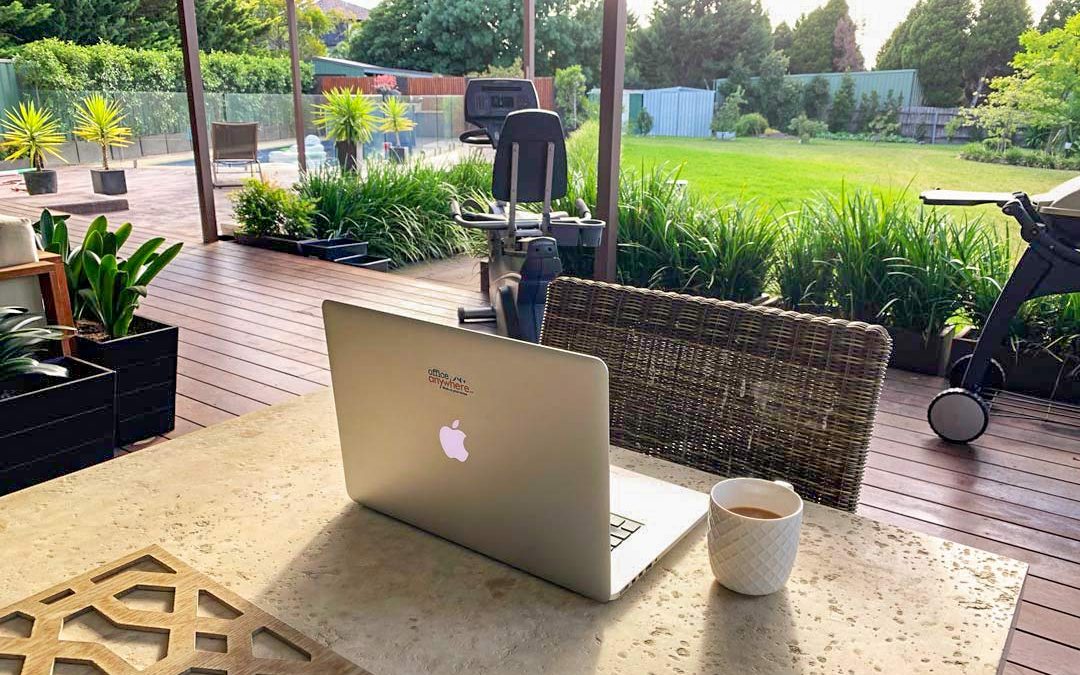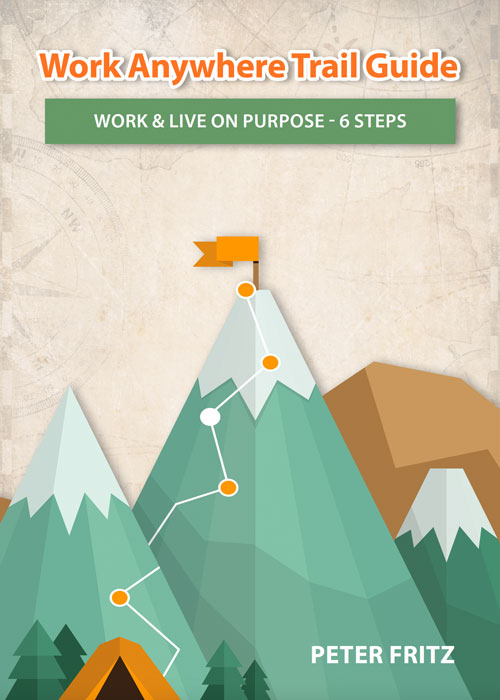[smart_track_player url=”http://traffic.libsyn.com/midlifetribe/If_youre_unhappy_dont_quit_your_job._Change_location_-_096.mp3″ background=”#f2f2f2″ social_gplus=”false” social_linkedin=”true” social_email=”true” ]
A quick Google search reveals most of us are stressed about work. Depending on whose research you read, around half of us love our jobs about as much as dental work. We’re leaving our families each morning to commute to a place we don’t like, to do things that make us unhappy.
This probably comes as no surprise, and I suspect it hasn’t changed much over the last half-century. What’s changed, though, is how we deal with it. Since Tim Ferriss published his seminal book, it seems everyone wants to quit their job, drink Margaritas and work four hours a week.
I reckon we’re being too hasty, though – that part of our dissatisfaction stems not from what we do but how we do it.
Forget what. Consider where.
I believe our environment has a greater impact on the way we feel about our work than the function we perform while working. In other words, many of us don’t need to quit our job, we just need to change how and where we do it.
Granted, there are myriad exceptions to this; a lot of jobs can’t be done somewhere else. But plenty can. I also know from experience that an exciting job can turn sour if one of your colleagues turns out to be an arsehole – especially if she’s your boss. Likewise, an ordinary job can take on a new lustre if your environment undergoes a favourable change.
I’ll give you an example. When I met my wife, she worked at a prestigious accounting firm that serviced Fortune 500 companies. She made good money, and as something of a mathematical genius, she had a bright future ahead of her. But it was mind-numbing work marred by rigid protocols, dressed in corporate grey. When she left to buy a dirty little Asian grocery, she was happier than a pig in mud. The work was harder and the hours were longer, but it was hers. Over the course of a year, she reshaped the environment into one she was proud of and then sold it for a profit.
She did this twice more – each time improving and then selling the business – until she arrived at the perfect arrangement; working from home on terms that suited her.
Today, she owns a lucrative online business. She spends her days fulfilling orders, answering emails and packing boxes. For extra fun, she sometimes spends an hour sticking bulk-purchased stamps onto envelopes. It’s not exciting, but because she does it from home with a view of the pool and the local birdlife, she loves it. She treats the stamps-on-envelopes exercise like meditation. If she did this kind of work inside a windowless factory in an industrial estate, she’d probably have to kill herself.
I’m much the same. If I had to work in a rigid office environment with fluoro lighting and weekly meetings, my job would be so painful I’d have quit a decade ago. But because I do it from anywhere I like (I only need a laptop and some Internet), I’ve remained creative, focused and happy for 21 years in the same job.
So, in celebration of the life-affirming benefits of working how, where and when you want, I thought I’d give you a rundown of my favourite places to do great work. And none of them required me to quit my job.
The Car
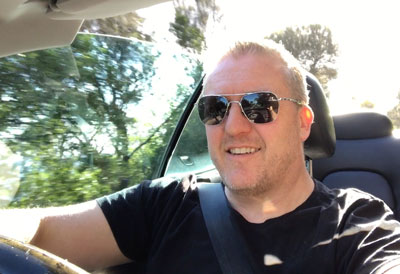 I’ve been driving since I was eight. No, really, that’s when my dad started teaching me on local dirt tracks. By the time I was twelve, I was driving a fully-loaded van with a trailer and two motorbikes through the Victorian High Country on camping trips. I love cars, and few things make me happier than a full tank of juice and a dot on a map 1,000 km away.\
I’ve been driving since I was eight. No, really, that’s when my dad started teaching me on local dirt tracks. By the time I was twelve, I was driving a fully-loaded van with a trailer and two motorbikes through the Victorian High Country on camping trips. I love cars, and few things make me happier than a full tank of juice and a dot on a map 1,000 km away.\
Whenever I’m stuck on a project or I need to flesh out an idea, I jump in my car and drive out to the country. While I’m driving, I record all my thoughts and ideas into the voice memo app on my phone. By the time I’m in the hills, I’ve usually gotten everything out and refined my thoughts to a point where I can document them and create some structure around the problem. I’ll stop at a park or a cafe and transcribe my voice memos into a document on my laptop. Once I have that, I begin setting out the tasks necessary to bring my project to life.
This approach remains one of my most productive exercises; it’s how the ideas behind this website and the course I’m building began. It’s how I formulate marketing strategies, plan exhibitions, design websites and define functional specs. It’s how all my best ideas take their initial form.
The Park Bench
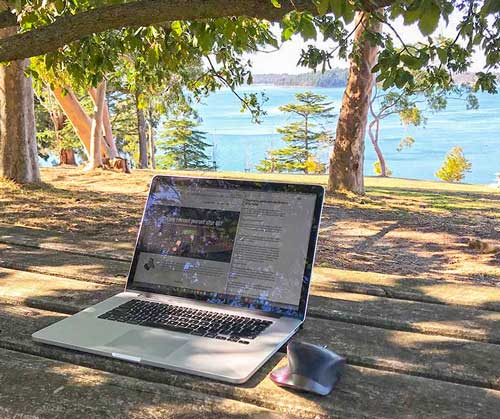 This is one of my favourite places to work. Years ago, I spent a week at Lake Mokoan, 200 km from my home. Each day, I’d drive there early in the morning, recording my ideas as I went. I’d then spend the rest of each day at a picnic table beside the lake, creating the specs for the software I was designing. It was one of the most productive weeks I’ve ever had. No distractions, plenty of fresh air and hours and hours of deep work.
This is one of my favourite places to work. Years ago, I spent a week at Lake Mokoan, 200 km from my home. Each day, I’d drive there early in the morning, recording my ideas as I went. I’d then spend the rest of each day at a picnic table beside the lake, creating the specs for the software I was designing. It was one of the most productive weeks I’ve ever had. No distractions, plenty of fresh air and hours and hours of deep work.
These days, I have a new favourite spot just 40 km from home. The views are better and I still get 45 minutes of thinking time in the car. When OfficeAnywhere was born, I was seated at a park bench under an old Elm tree, looking out to the glass-blue waters of Yan Yean Reservoir.
The Garage
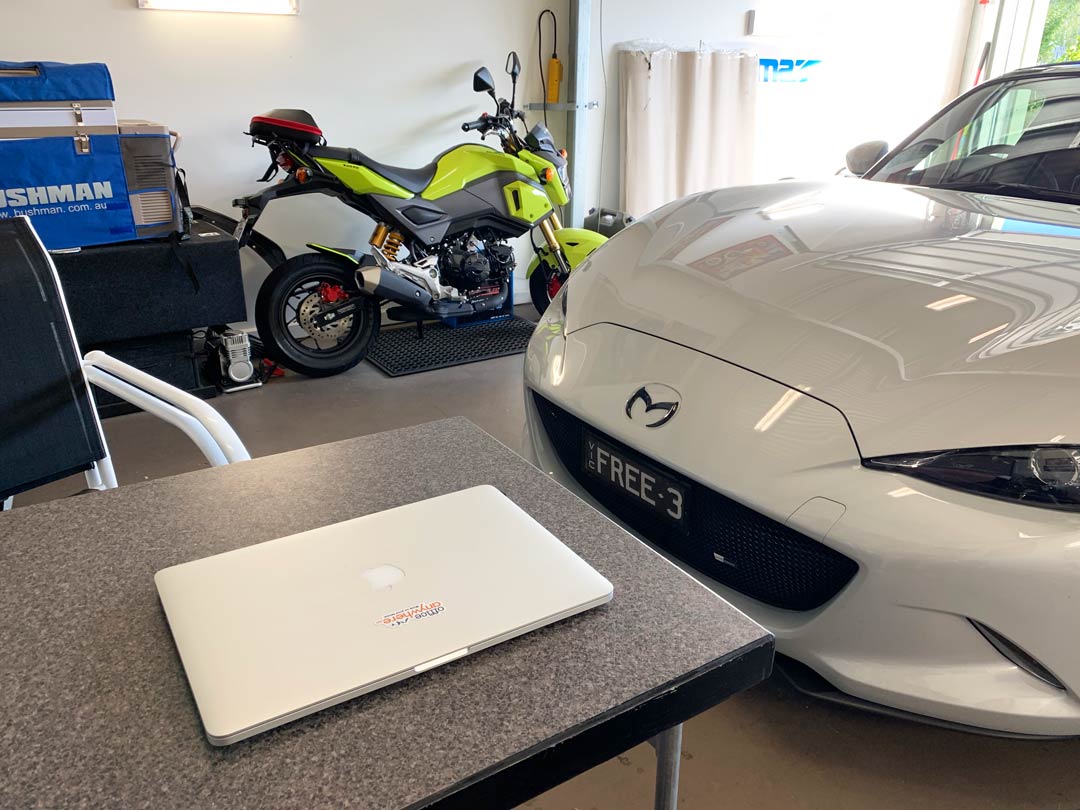
Up until a few months ago, I had a ritual involving red wine, a cigar and a small plate of vintage cheese. At around six every evening, I’d take these items and my laptop into my garage and write. Many of my earlier blog posts came from there, as did much of my first book. It’s far enough away to be distraction-free but close enough if I’m needed for something.
I also love that I’m surrounded by things that make me smile – my camping gear, my motorbike and my convertible. Tommy’s motorbike now lives there, too – a new kind of happy feeling.
Nowadays, the cigars and cheese are gone, but the Shiraz remains. Two glasses of alcohol a day are said to reduce the risk of heart attack, stroke and cancer by percentages in the double digits, so I’m sticking with it. Plus, it’s easier to write with wine. It just is.
The Dining Room
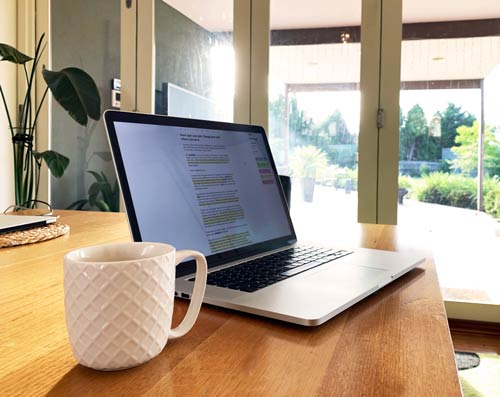 I like to be up at dawn; earlier if I can manage. Our dining room bi-folds look out to the east towards the deck and the sunrise. Dawn has always been a special time for me, thanks to my previous life as a photographer. The magic hours of dawn and dusk are when some of the best photographs are made, and I’ve spent hundreds of them in locations around the country waiting for the right moment to click the shutter.
I like to be up at dawn; earlier if I can manage. Our dining room bi-folds look out to the east towards the deck and the sunrise. Dawn has always been a special time for me, thanks to my previous life as a photographer. The magic hours of dawn and dusk are when some of the best photographs are made, and I’ve spent hundreds of them in locations around the country waiting for the right moment to click the shutter.
So my day always begins here with a cup of Assam Bold laced with Manuka honey. If it’s summer, the deck is where you’ll find me (see main pic). After half an hour, it’s then onto writing. Doing this in the calm of first light is perfect – everything aligns to make it the best time to do creative work. I usually stop within an hour before moving onto my #1 priority for the day – either my website or a product I’m creating.
By 8:00 am, my wife and son are up and the ‘get the little guy off to school’ routine kicks in. After walking back from his school, my normal day begins in my home office.
The Perfect Home Office
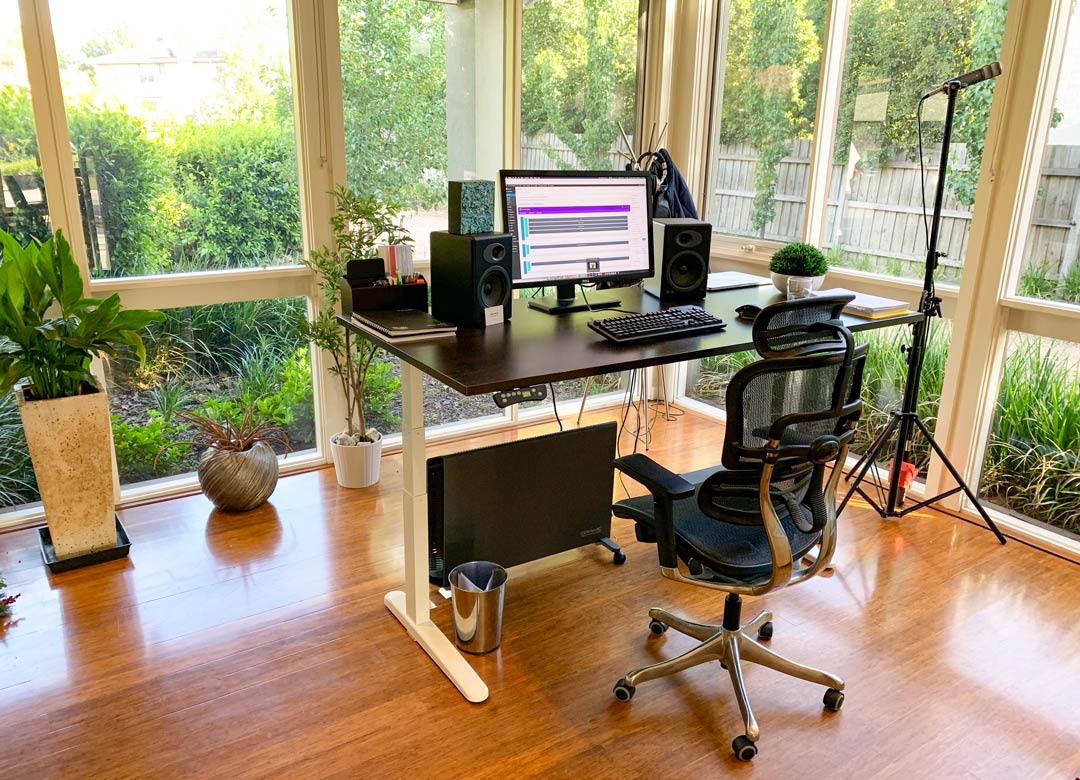
It’s been a dream for decades to have a space that’s just mine – somewhere to do my best work. My home office has floor-to-ceiling windows on two sides that catch the arc of the sun throughout the day. Greenery surrounds me, and everywhere I look I see things that make me smile: a drawing from my daughter, photos of my family, a huge canvas print of the Flinders Ranges in outback South Australia, taken on a drive across the desert to Perth.
A glass-doored cabinet houses my most treasured books from the likes of Godin, Pressfield, Singer, Zander, Frankl, Altucher, Guillebeau, Clear, Robbins, Crowley, Manson and Ruiz. Lifetimes of wisdom in one place.
My fabulous electric height-adjustable desk houses the things I need to do my best work and nothing more; it’s not a filing cabinet nor a halfway house for detritus. On it sits my MacBook Pro, a 27-inch DELL QHD monitor, a DAS keyboard and a pair of Audioengine A5+ speakers. A small box of items and two stacks of papers (one for my current project and one for ‘soon’ projects) round out the setup.
I’m sitting here right now on my Ergohuman V2 chair, looking out at the London Plane I planted five years ago. Rows of Liriope Evergreens trace an outline of my office while up to my right sits a million square kilometres of blue sky. I sometimes wonder how I sat in traffic for two hours a day; how I remained sane in my cubicle or produced anything valuable in that setting. That’s why I escaped to places like Lake Mokoan; it’s why I began working from home all those years ago. The bottom line is I valued my time, my output and my sanity.
Today, my home office is a place where great things happen – distraction-free and fuelled by creativity, good coffee and great music. Wild horses wouldn’t drag me away, not even for triple the money.
Change your environment. Change your life.
I started out by saying that half of us hate our jobs. As a father of teenage girls, I’ve had this conversation many times. I tell Amy and Sarah there are three critical elements to happiness at work:
- What you do
- Where you do it
- How you do it
It’s not enough to enter a field you like. If you’ve dreamed of being an architect but the environment sucks or the commute, the people or the rules suck, your life will suck, too.
Chasing money or a job title, or even an altruistic notion of what a job should be isn’t enough, either. You spend most of your waking hours at work, so being happy doing it should be a huge priority.
Changing where and how you work can have a massive impact on your relationship to it. Even a tedious job can become a joy because once you have agency over your environment and your daily routine, life becomes so much easier. The additional free time presents some tantalising options, too.
My advice, then, is simple. You don’t need to quit your job to be happy. You might only need to change how and where you’re doing it. And if you do change jobs, you might want to give more thought to how and where you’ll do it versus how much they’ll pay you and what your job title will be.
At the end of the day, the happiest people are those in charge of their lives. Controlling how and where you do your work is one of the most profound expressions of that ideal.
Peter
.
[ss_click_to_tweet tweet=”You don’t need to quit your job to be happy. Instead, change how and where you do it.” content=”You don’t need to quit your job to be happy. Instead, change how and where you do it.” style=”5″ link=”1″ via=”1″]
Related Stories
Work from home but keep your day job.
How to nail what you want out of life.
3 Habits Every Remote Worker Should Have
Remote workers are good for business – statistics prove it.
Working from home – my typical day as a remote worker.
Changing Jobs or Careers – How to Find One That Fits
Why I work from home, and why it might be right for you, too.
The Ultimate Goal – A Dedication to Jon James
Yesterday, a giant in my life called up to offer his final farewell. Today, he married his true love, Aurelia, before entering palliative care. He’s only 64, he’s athletic, and he's stronger than most 30-year-olds. But when cancer takes hold, it doesn’t care. Jonathon...
What are the first steps to starting a side business that makes you money?
[fusebox_track_player url="https://www.buzzsprout.com/1079927/5461972-what-are-the-first-steps-to-starting-a-side-business-ep-115.mp3?blob_id=22247092&download=true" title="What are the first steps to starting a side-business? - EP 115" social_linkedin="true"...
The purpose of purpose
[fusebox_track_player url="https://www.buzzsprout.com/1079927/5195959-the-purpose-of-purpose-ep-114.mp3?blob_id=20946406&download=true" title="The Purpose of Purpose - EP 114" social_linkedin="true" social_email="true" ]Recorded with SquadCastSubscribe: iTunes |...
Download the Guide

